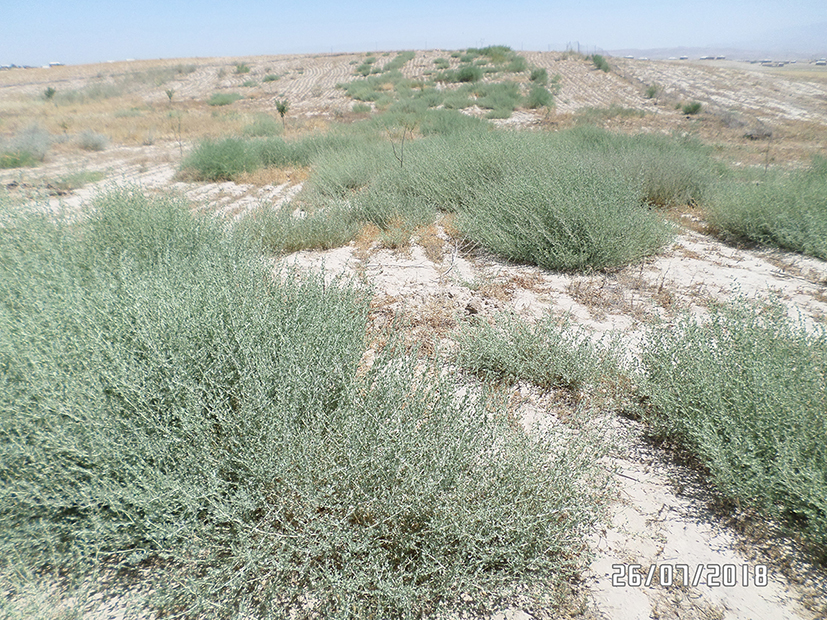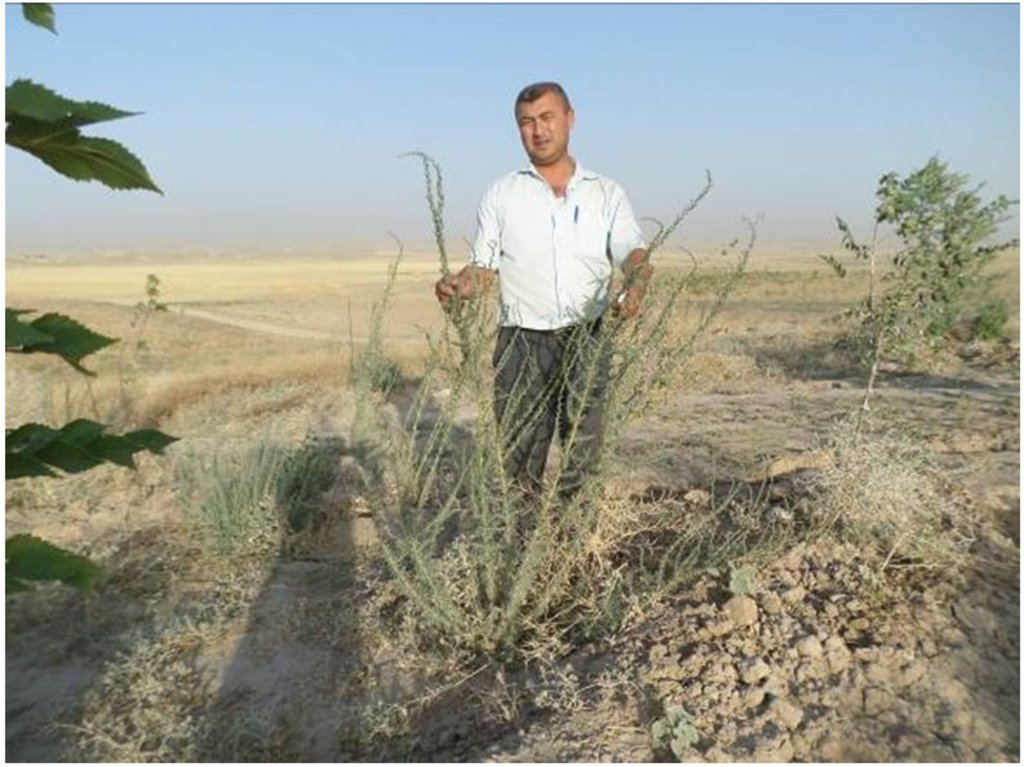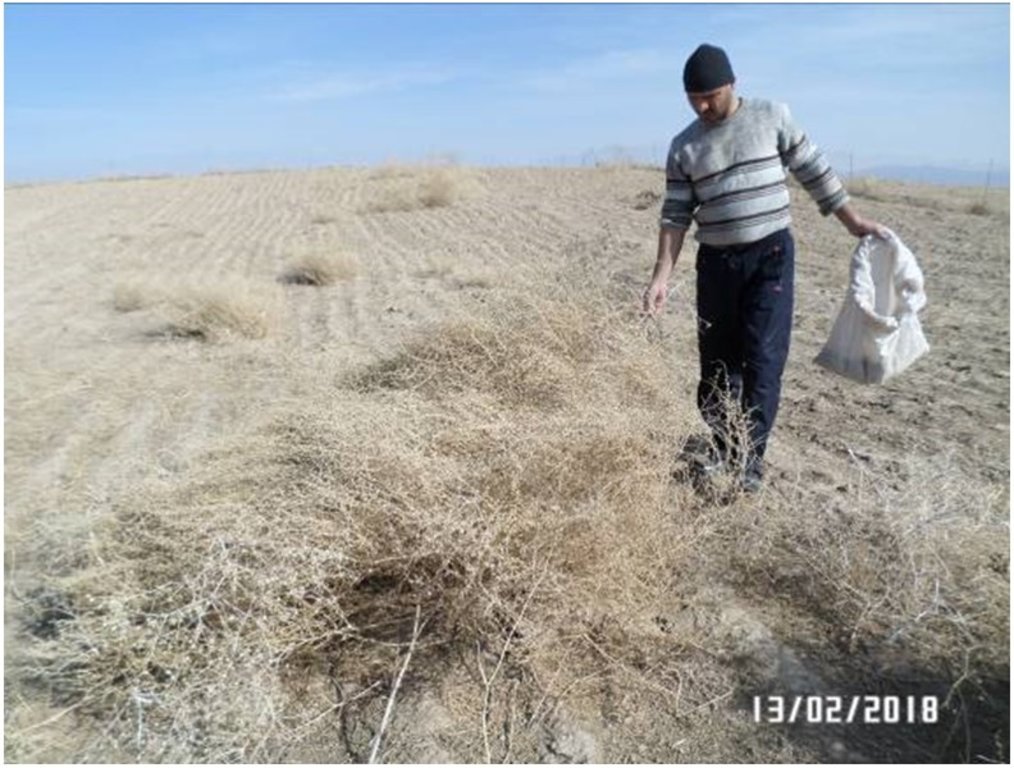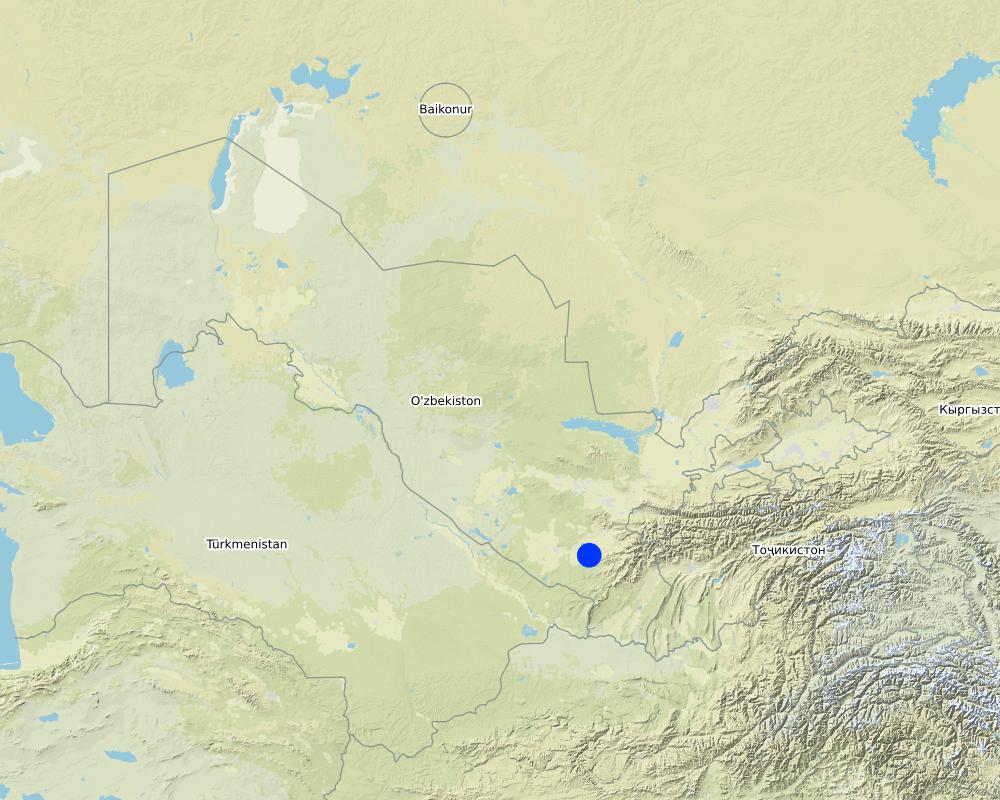Drought-resistant crops to enhance forage production and prevent erosion in desert areas [Uzbekistan]
- Creation:
- Update:
- Compiler: Rustam Ibragimov
- Editor: –
- Reviewers: Alexandra Gavilano, Elizaveta Soloveyva, Olga Andreeva
Drought-resistant crops to enhance forage production and prevent erosion in desert areas
technologies_3650 - Uzbekistan
- Full summary as PDF
- Full summary as PDF for print
- Full summary in the browser
- Full summary (unformatted)
- Выращивание пустынных засухоустойчивых культур на богаре для повышения кормопроизводства и предотвращения эрозии: Sept. 11, 2018 (inactive)
- Выращивание пустынных засухоустойчивых культур на богаре для повышения кормопроизводства и предотвращения эрозии: Aug. 22, 2019 (inactive)
- Drought-resistant crops to enhance forage production and prevent erosion in desert areas: Jan. 21, 2020 (public)
View sections
Expand all Collapse all1. General information
1.2 Contact details of resource persons and institutions involved in the assessment and documentation of the Technology
Key resource person(s)
SLM specialist:
Mukimov Tolibjon, Khudaykulovich
Scientific research Institute of Karakul sheep breeding and ecology of deserts
Uzbekistan
Name of project which facilitated the documentation/ evaluation of the Technology (if relevant)
Decision Support for Mainstreaming and Scaling out Sustainable Land Management (GEF-FAO / DS-SLM)Name of the institution(s) which facilitated the documentation/ evaluation of the Technology (if relevant)
Design and Research UZGIP Institute, Ministry of Water Resources (UzGIP) - Uzbekistan1.3 Conditions regarding the use of data documented through WOCAT
The compiler and key resource person(s) accept the conditions regarding the use of data documented through WOCAT:
Yes
1.4 Declaration on sustainability of the described Technology
Is the Technology described here problematic with regard to land degradation, so that it cannot be declared a sustainable land management technology?
No
2. Description of the SLM Technology
2.1 Short description of the Technology
Definition of the Technology:
Desert fodder plants cultivation in rainfed conditions provides adaptation to drought, creates feed reserves for livestock and prevents the water erosion development
2.2 Detailed description of the Technology
Description:
Animal husbandry is the main source of livelihoods and well-being for the population living in the rainfed zone (the share in the family budget is 80-95%). The creation of a stable fodder base capable of ensuring the livestoсk development and solving the problem of biodiversity conservation while meeting the vital needs of the population is the main task. The productivity of rainfed pastures in Uzbekistan is highly depend on weather conditions and varies sharply over years and seasons (from 1.5-2.0 to 5 centner / ha). Inefficient use of pastures, poor use of measures to restore degraded areas caused a significant increase in anthropogenic pressure on pastures, which contributed to their degradation. Cultivation of desert fodder plants on rainfed lands, such as Kochia prostrata, Halothamus subaphylla, Ceratoides ewersmanniana, Atriplex undulata, which are most adapted to soil and air drought, will create additional feed reserves, reduce the stocking level and ensure balanced nutrition of animals. In the first year of vegetation, the yield of desert plants is 1.5-1.6 C / ha of dry weight, in the second year-2.2-3.5 C / ha of dry fodder weight and about 0.4 C / ha of seeds; in the third year, 8-12 C / ha of dry weight and 1.0-1.2 C / ha of seeds. With proper use of seed crops and pasture agrophytocenoses, these plant communities are able to recover themselves within 20-35 years. Costs of inputs needed for establishment: in order to implement the technology on rainfed lands, it is necessary to establish primary seed nurseries to provide seeds to land users.
The technology of desert plants cultivation includes plowing to a depth of 20-22 cm, harrowing, levelling. Sowing is carried out in December - February with a seeding rate of 12-15 kg / ha, to a depth of 0.5-2 cm. Harvesting of seeds is carried out in October-November. Seeds are cleaned, dried and stored under the condition of humidity not more than 12%. With this storage method, the seeds do not lose their germination within 6-9 months after harvesting. To create primary seed nurseries in rainfed lands, about 700,000-850,000 Uzbek soum / ha is required (within the range of 100 USD/ ha).
Natural / social environment: low availability of precipitation and soil water and wind erosion are the features of rainfed lands. To increase land productivity, areas under drought-resistant crop species such as safflower are currently expanding . Finding alternative solutions and supporting the local community is the main task to improve living standards and well-being. Cultivation of perennial desert forage plants for forage production provides support to pastoralists and farmers. The technology provides environmental benefits, contributes to climate change mitigation by sequestering CO2 in plant biomass and soil (up to 480 kg / ha) and contributes to overall environmental health.
2.3 Photos of the Technology
2.5 Country/ region/ locations where the Technology has been applied and which are covered by this assessment
Country:
Uzbekistan
Region/ State/ Province:
Kamashinsky district, Kashkadarya region
Further specification of location:
Kamashi
Specify the spread of the Technology:
- applied at specific points/ concentrated on a small area
Comments:
Technology implementation and adaptation is carried out on the degraded lands of the rainfed zone (1 ha)
Map
×2.6 Date of implementation
Indicate year of implementation:
2015
If precise year is not known, indicate approximate date:
- less than 10 years ago (recently)
2.7 Introduction of the Technology
Specify how the Technology was introduced:
- through projects/ external interventions
Comments (type of project, etc.):
Experiments and studies were conducted by Uzbekistan scientists 30 years ago. The Technology was implemented as part of the GEF / FAO / WOCAT Project Decision Support for Mainstreaming and Scaling out Sustainable Land Management (GEF-FAO / DS-SLM)
3. Classification of the SLM Technology
3.1 Main purpose(s) of the Technology
- improve production
- reduce, prevent, restore land degradation
- preserve/ improve biodiversity
- adapt to climate change/ extremes and its impacts
- mitigate climate change and its impacts
- create beneficial economic impact
- Forage production base development and guaranteed feed reserves in order to increase livestock productivity and reduce the stocking level
3.2 Current land use type(s) where the Technology is applied

Grazing land
Extensive grazing:
- Semi-nomadic pastoralism
- Полукочевое/ отгонное животноводство, Поголовье скота на единицу площади (если применимо): 2 головы на 1 гектар
- Small and large cattle (wool, meat, milk)
Comments:
Agricultural fields (arable lands) and plantations: degraded lands of the rainforest zone, on which grain crops were previously cultivated
3.4 Water supply
Water supply for the land on which the Technology is applied:
- rainfed
Comments:
Number of harvests per year:
2
Explain:
2 forage crops (spring and autumn)
3.5 SLM group to which the Technology belongs
- integrated crop-livestock management
- improved ground/ vegetation cover
3.6 SLM measures comprising the Technology

agronomic measures
- A1: Vegetation/ soil cover

vegetative measures
- V2: Grasses and perennial herbaceous plants

management measures
- M1: Change of land use type
3.7 Main types of land degradation addressed by the Technology

soil erosion by water
- Wt: loss of topsoil/ surface erosion

soil erosion by wind
- Et: loss of topsoil

biological degradation
- Bc: reduction of vegetation cover
Comments:
Natural causes of degradation: lack of rainfall, wind and water erosion on the slopes;
Anthropogenic causes of degradation: lack of protective forest belts, poor agricultural tillage, lack of techniques and methods that reduce evaporation from the soil surface and increase moisture accumulation, lack of diversity of drought-resistant varieties and species of cultivated plants, etc.
3.8 Prevention, reduction, or restoration of land degradation
Specify the goal of the Technology with regard to land degradation:
- reduce land degradation
- restore/ rehabilitate severely degraded land
Comments:
Increasing the land productivity due to intensive cultivation and incorporation of legumes, the increase of biodiversity
4. Technical specifications, implementation activities, inputs, and costs
4.1 Technical drawing of the Technology
Technical specifications (related to technical drawing):
Sowing of desert drought-resistant plants is carried out on 5 m wide strips with alternation of different species. The seeding rate is 12-15 kg / ha, seed planting is carried out by harrowing to a depth of 0.5-2 cm. This sowing scheme provides biological diversity and optimal density of vegetation.
Author:
T. Mukimov
4.2 General information regarding the calculation of inputs and costs
Specify how costs and inputs were calculated:
- per Technology area
Indicate size and area unit:
1 ha
Specify currency used for cost calculations:
- USD
If relevant, indicate exchange rate from USD to local currency (e.g. 1 USD = 79.9 Brazilian Real): 1 USD =:
4150.0
Indicate average wage cost of hired labour per day:
4, 75 USD
4.3 Establishment activities
| Activity | Timing (season) | |
|---|---|---|
| 1. | Planning, plowing, levelling, harrowing | During Winter-Spring |
| 2. | Sowing | December-February |
| 3. | Crop care | April - May |
| 4. | Harvest | May-October |
| 5. | Site Protection | During the growing season |
Comments:
The establishment activities include usual agricultural techniques of sowing crops in compliance with the crop specifics (seeding depth, seeding rate, etc.)
4.4 Costs and inputs needed for establishment
| Specify input | Unit | Quantity | Costs per Unit | Total costs per input | % of costs borne by land users | |
|---|---|---|---|---|---|---|
| Labour | Hired labor on planting | USD/ha | 1.0 | 60.0 | 60.0 | |
| Equipment | The use of machinery in sowing | USD/ha | 1.0 | 21.0 | 21.0 | |
| Plant material | Seeds of desert plants | USD/ha | 1.0 | 40.0 | 40.0 | |
| Construction material | Site fencing | USD/ha | 1.0 | 200.0 | 200.0 | |
| Total costs for establishment of the Technology | 321.0 | |||||
| Total costs for establishment of the Technology in USD | 0.08 | |||||
If land user bore less than 100% of costs, indicate who covered the remaining costs:
paid by the project
4.5 Maintenance/ recurrent activities
| Activity | Timing/ frequency | |
|---|---|---|
| 1. | Crop care | during the growing season |
| 2. | Harvest | 2- times during flowering and fruiting |
| 3. | Site Protection | during the growing season |
4.6 Costs and inputs needed for maintenance/ recurrent activities (per year)
| Specify input | Unit | Quantity | Costs per Unit | Total costs per input | % of costs borne by land users | |
|---|---|---|---|---|---|---|
| Labour | Hired labor on planting | USD/ha | 1.0 | 60.0 | 60.0 | 100.0 |
| Plant material | Harvest | USD/ha | 1.0 | 40.0 | 40.0 | 100.0 |
| Total costs for maintenance of the Technology | 100.0 | |||||
| Total costs for maintenance of the Technology in USD | 0.02 | |||||
If you are unable to break down the costs in the table above, give an estimation of the total costs of maintaining the Technology:
100.0
4.7 Most important factors affecting the costs
Describe the most determinate factors affecting the costs:
The largest costs in the first year of technology implementation are related to the purchase of seeds and fencing of the plot from livestock
5. Natural and human environment
5.1 Climate
Annual rainfall
- < 250 mm
- 251-500 mm
- 501-750 mm
- 751-1,000 mm
- 1,001-1,500 mm
- 1,501-2,000 mm
- 2,001-3,000 mm
- 3,001-4,000 mm
- > 4,000 mm
Specify average annual rainfall (if known), in mm:
120.00
Specifications/ comments on rainfall:
90% of precipitation falls in October-may
Indicate the name of the reference meteorological station considered:
Kamashi
Agro-climatic zone
- semi-arid
The duration of the growing season of natural vegetation is 90-100 days
5.2 Topography
Slopes on average:
- flat (0-2%)
- gentle (3-5%)
- moderate (6-10%)
- rolling (11-15%)
- hilly (16-30%)
- steep (31-60%)
- very steep (>60%)
Landforms:
- plateau/plains
- ridges
- mountain slopes
- hill slopes
- footslopes
- valley floors
Altitudinal zone:
- 0-100 m a.s.l.
- 101-500 m a.s.l.
- 501-1,000 m a.s.l.
- 1,001-1,500 m a.s.l.
- 1,501-2,000 m a.s.l.
- 2,001-2,500 m a.s.l.
- 2,501-3,000 m a.s.l.
- 3,001-4,000 m a.s.l.
- > 4,000 m a.s.l.
Indicate if the Technology is specifically applied in:
- not relevant
5.3 Soils
Soil depth on average:
- very shallow (0-20 cm)
- shallow (21-50 cm)
- moderately deep (51-80 cm)
- deep (81-120 cm)
- very deep (> 120 cm)
Soil texture (topsoil):
- medium (loamy, silty)
Soil texture (> 20 cm below surface):
- fine/ heavy (clay)
Topsoil organic matter:
- low (<1%)
5.4 Water availability and quality
Ground water table:
5-50 m
Availability of surface water:
poor/ none
Water quality (untreated):
good drinking water
Is water salinity a problem?
No
Is flooding of the area occurring?
No
Comments and further specifications on water quality and quantity:
Forage crops are grown without irrigation
5.5 Biodiversity
Species diversity:
- low
Habitat diversity:
- low
Comments and further specifications on biodiversity:
The vegetation of rainfed lands is represented mainly by cultivated plants (winter wheat, safflower). After harvesting, the soil surface dries up and remains without vegetation due to lack of rainfall
5.6 Characteristics of land users applying the Technology
Sedentary or nomadic:
- Sedentary
Market orientation of production system:
- mixed (subsistence/ commercial)
Off-farm income:
- > 50% of all income
Relative level of wealth:
- average
Individuals or groups:
- cooperative
Level of mechanization:
- mechanized/ motorized
Gender:
- men
Age of land users:
- middle-aged
5.7 Average area of land used by land users applying the Technology
- < 0.5 ha
- 0.5-1 ha
- 1-2 ha
- 2-5 ha
- 5-15 ha
- 15-50 ha
- 50-100 ha
- 100-500 ha
- 500-1,000 ha
- 1,000-10,000 ha
- > 10,000 ha
Is this considered small-, medium- or large-scale (referring to local context)?
- medium-scale
5.8 Land ownership, land use rights, and water use rights
Land ownership:
- state
- individual, titled
Land use rights:
- leased
Water use rights:
- individual
- Вода для питья в основном привозная из-за отсутствия поверхностных источников и глубокого залегания подземных вод. Оросительная вода отсутствует
5.9 Access to services and infrastructure
health:
- poor
- moderate
- good
education:
- poor
- moderate
- good
technical assistance:
- poor
- moderate
- good
employment (e.g. off-farm):
- poor
- moderate
- good
markets:
- poor
- moderate
- good
energy:
- poor
- moderate
- good
roads and transport:
- poor
- moderate
- good
drinking water and sanitation:
- poor
- moderate
- good
financial services:
- poor
- moderate
- good
6. Impacts and concluding statements
6.1 On-site impacts the Technology has shown
Socio-economic impacts
Production
fodder production
fodder quality
Income and costs
expenses on agricultural inputs
farm income
Comments/ specify:
Net income of 2.5 million Uzbek soums
workload
Ecological impacts
Soil
soil accumulation
Biodiversity: vegetation, animals
Vegetation cover
biomass/ above ground C
plant diversity
Climate and disaster risk reduction
drought impacts
micro-climate
6.2 Off-site impacts the Technology has shown
impact of greenhouse gases
Specify assessment of off-site impacts (measurements):
The Technology does not negatively affect the environment; Some species of legumes improve the soil, biodiversity increases, due to the full phytocenosis (shrubs, semi-shrubs, grasses) and the development of herbaceous vegetation.
6.3 Exposure and sensitivity of the Technology to gradual climate change and climate-related extremes/ disasters (as perceived by land users)
Gradual climate change
Gradual climate change
| Season | increase or decrease | How does the Technology cope with it? | |
|---|---|---|---|
| annual temperature | increase | very well | |
| seasonal temperature | summer | increase | well |
| annual rainfall | decrease | well | |
| seasonal rainfall | spring | decrease | well |
| seasonal rainfall | summer | decrease | well |
Climate-related extremes (disasters)
Climatological disasters
| How does the Technology cope with it? | |
|---|---|
| heatwave | well |
| drought | well |
Other climate-related consequences
Other climate-related consequences
| How does the Technology cope with it? | |
|---|---|
| extended growing period | very well |
6.4 Cost-benefit analysis
How do the benefits compare with the establishment costs (from land users’ perspective)?
Short-term returns:
slightly positive
Long-term returns:
positive
How do the benefits compare with the maintenance/ recurrent costs (from land users' perspective)?
Short-term returns:
slightly positive
Long-term returns:
positive
Comments:
Short-term positive benefits: increased yields and stocks of high-grade guaranteed feed for livestock in the autumn-winter period. Long-term positive benefits: the conservation and enhancement of biodiversity , the stocking level reduce
6.5 Adoption of the Technology
- 11-50%
Of all those who have adopted the Technology, how many did so spontaneously, i.e. without receiving any material incentives/ payments?
- 11-50%
6.6 Adaptation
Has the Technology been modified recently to adapt to changing conditions?
No
6.7 Strengths/ advantages/ opportunities of the Technology
| Strengths/ advantages/ opportunities in the land user’s view |
|---|
| Production of additional feed for livestock |
| Additional source of income |
| Low investment in technology |
| Strengths/ advantages/ opportunities in the compiler’s or other key resource person’s view |
|---|
| Does not require special investments in technology implementation |
| Fast income generation; up to 2.5 million Uzbek soums of net income from each hectare for the third year, up to 3.5 million Uzbek soums due to the sale of seeds and the use of hay |
6.8 Weaknesses/ disadvantages/ risks of the Technology and ways of overcoming them
| Weaknesses/ disadvantages/ risks in the land user’s view | How can they be overcome? |
|---|---|
| Lack of awareness raising about the possibility of applying the technology | spread of knowledge |
| Lack of desert grass seed |
| Weaknesses/ disadvantages/ risks in the compiler’s or other key resource person’s view | How can they be overcome? |
|---|---|
| In the conditions of rainfed lands, there is a low germination of desert grass seeds (guaranteed shoots can be obtained 1 time in 3-4 years) | Using recommendations and modern technologies of sowing |
7. References and links
7.1 Methods/ sources of information
- field visits, field surveys
September, 2015-2017
- interviews with land users
6 persons
- interviews with SLM specialists/ experts
3 persons
- compilation from reports and other existing documentation
Reports and technologies ICARDA, IKBA, NIIKEP, GIZ
When were the data compiled (in the field)?
21/11/2016
7.2 References to available publications
Title, author, year, ISBN:
Mukimov T. et al. Current state of foothill pastures in the Farish region and local participation in their use and restoration. 2013
Available from where? Costs?
Papers of scientific and practical conference. Tashkent
Title, author, year, ISBN:
Khamzina T. I. et al. Practices And Technologies For Sustainable Use Of Irrigated And Rainfed Lands Subject To Salinization And Drought 2017
Available from where? Costs?
Papers of scientific and practical conference. Tashkent
Title, author, year, ISBN:
Mukimov T/ Uzbekistan -- Rangelands and Pasturelands: Problems and Prospects 2017
Available from where? Costs?
Adelaide, Australia, NOVA
Links and modules
Expand all Collapse allLinks
No links
Modules
No modules







